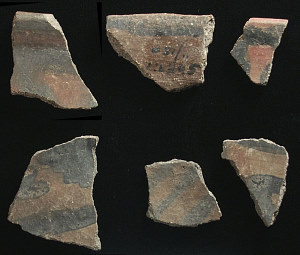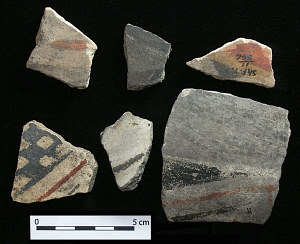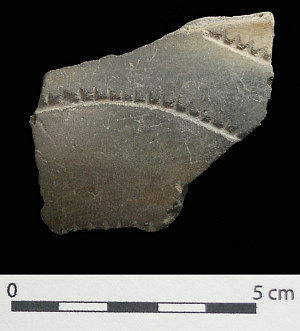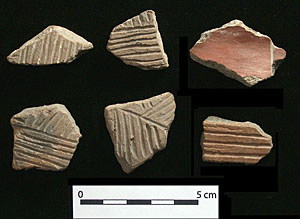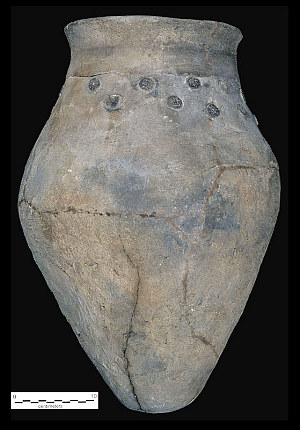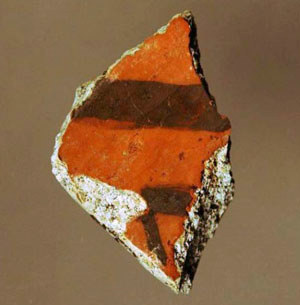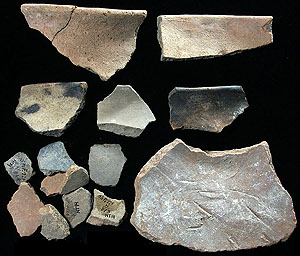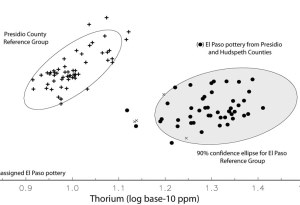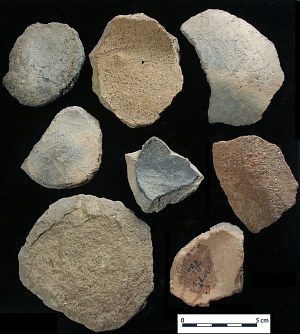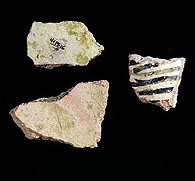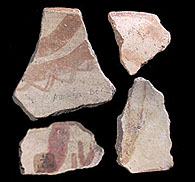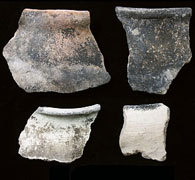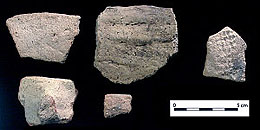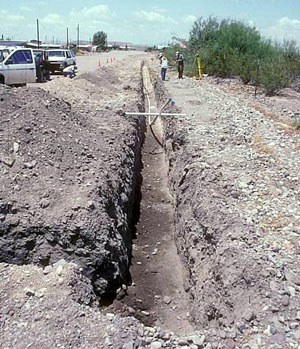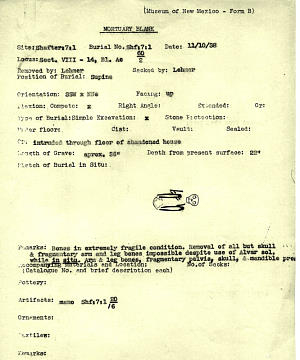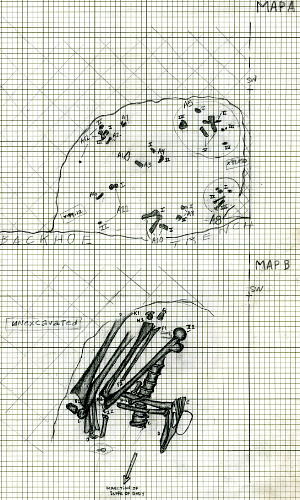New Insights
|
Throughout this exhibit we have highlighted the pioneering research of J. Charles Kelley, the archeologist and ethnohistorian who synthesized most of what has been learned about native life at La Junta. While Kelley refined certain of his ideas over the years, most of the interpretations he put forth in the 1940s and 1950s still stand, some more securely than others. Today many of Kelley's interpretations serve as hypotheses—trial explanations—that current researchers seek to evaluate (test). Recent field investigations in the La Junta area (see Investigations and Sites) have yielded new data that are being analyzed today along with some of the archeological collections made in the 1930s and 1940s. This ongoing research is helping us reevaluate Kelley's ideas, ask new questions, and put forth new ideas. Two analytical arenas have proven particularly insightful, the study of pottery and the study of mortuary and health patterns. Most of the results of this work have not yet appeared in print, hence they are summarized in some detail below. La Junta PotteryPottery (ceramics) is one of the most informative artifact classes found at La Junta. Pottery fragments are found in all La Junta villages and they are virtually imperishable, being hard pieces of fired clay that are resistant to deterioration. Collectively, the pottery found at La Junta and across the American Southwest is quite varied and made in many different places, from many different clay sources with various kinds of added tempering agents, using various pottery-making techniques. Vessel forms range from water jars to cooking pots to serving bowls and more. Many vessels were painted or decorated in other ways such as polished or textured surfaces. By studying such variation, archeologists have defined many different styles or "types" of pottery made by various cultures in the American Southwest. Styles changed through time and pottery was often traded. Pottery was locally made at La Junta, especially in historic times, and pottery was made elsewhere and imported, especially during prehistoric times. Researchers have begun to study the pottery of La Junta in more detail in recent years, taking advantage of a nuclear "sourcing" technique called Instrumental Neutron Activation Analysis (INAA) that can help pin-point where pottery was made. The results of this work can be coupled with petrographic analysis, the identification of rocks and minerals characteristic of clay sources and added temper by the microscopic examination of "thin sections" cut from sherds. Thousands of sherds were recovered from Millington, Loma Alta, and the Polvo sites in the 1930s and 1940s, and smaller numbers from other sites. Kelley categorized and provisionally classified most of this pottery, and recognized distinctive patterns. These ceramic patterns were, in fact, the basis for many of his interpretations. Many types of Southwestern pottery found at La Junta had already been recognized and named by the archeologists of the day. And the approximate ages of many types of Southwestern pottery had been determined because of their association with tree-ring dated deposits and by cross-dating distinctive types that were characteristically found together. Thus Kelley recognized that the most common pottery associated with the La Junta phase was El Paso Polychrome, a brown earthenware pottery decorated with red, black, and brown designs. El Paso Polychrome was thought to date to the 13th and 14th centuries A.D., allowing Kelley to establish the approximate age of the La Junta phase. Today the dating of El Paso Polychrome has changed little, although it is now much more firmly established as having been made between A.D. 1200 and A.D. 1450 and has been shown to have indeed been produced mainly in the Hueco Bolson and in the local area surrounding El Paso in south-central New Mexico and far western Texas. La Junta phase sites have yielded examples of many other kinds of Southwestern pottery, especially those made by Casas Grandes peoples. There are also other kinds of pottery made in the Mogollon area of southern New Mexico and a few pieces from as far away as southern Arizona. These are clearly trade wares—pots that were imported into La Junta from distant places, although many of these vessels may not have been traded as commodities, per se. They may well have been gifts passed along from one group to the next that helped cement social relationships across the region. Some may also have been brought to La Junta as containers for traded commodities. Kelley also recognized an abundance of locally made pottery that he thought was made after A.D. 1500. Although he briefly characterized and provisionally named various types of locally made pottery, he was never satisfied with his pottery classification and did not publish formal type definitions. He knew that this previously unknown pottery tradition needed further study and better dating. In fact, the local pottery tradition has never been given a proper name. Here we will call it La Junta ware as it appears to be unique to the La Junta district. (See Credits & Sources to download Kelley's preliminary La Junta ceramic descriptions .) So far, the La Junta ware tradition has still not been properly studied and formally described. Steps are being taken, but this is a big job. A major problem is that most of the collections now available for study are from general site collections, not from dated deposits. The precise provenience of most of the ceramics recovered by the WPA digs at Millington and Loma Alta is not known; the collections were never properly curated and maintained. This is unfortunate, because tightly provenienced (and dated) samples are needed to pin down when different variants were made and to evaluate how the La Junta ware tradition changed through time. Another difficulty is that very little archeological investigation has been done along the entire Río Conchos and more generally in eastern and southern Chihuahua. We know that in early historic times La Juntans were in close contact with, and sometimes directly related to the Conchos groups and other tribes that lived in the middle and upper Río Conchos. We suspect that the early villagers of La Junta may well have been connected to the native peoples that lived up the Río Conchos, but the nature of their relationships are not yet known. One of the major research issues in the study of La Junta pottery is when did ceramics, and by extension settled villages, first appear in the area? According to Kelley, pottery did not appear at La Junta until A.D. 1200-1250 when the first villagers arrived from the El Paso area. If so, La Junta would have been practically the last place in the American Southwest to see pottery. While this could have been the case, frankly we doubt it. Plain brown and red-slipped brownware ceramics are common in archeological assemblages across eastern Arizona, southern New Mexico, and northwestern Mexico by the third century A.D. These are the same regions from which a wide range of pottery styles were traded into the La Junta area after A.D. 1200. Evidence from the Arroyo de la Presa site hints that earlier pottery may be present at La Junta. Five sherds representing two different types of polished brownware pottery were found there. These were designated Chihuahuan Brownware I and II based on the results of petrographic analysis and INAA source data. These studies determined that the pottery was not produced at La Junta, nor was it made in the El Paso area or other well-known source areas. Instead these brownwares are thought to have originated in an as-yet-unidentified source area, perhaps in southern Chihuahua. Two of the four highly polished brownware sherds from Arroyo de la Presa designated as Chihuahuan Brownware I were uncovered on an apparent living surface adjacent to a trash pit dated by two radiocarbon assays to A.D. 1040-1260, at the outset of, or just before, the La Junta phase. The single sherd of Chihuahuan Brownware II was found within a stratigraphic layer though to date to between A.D. 700-900, considerably earlier than the accepted date of the La Junta phase. One sherd is not enough to make a case for earlier village life at La Junta, but it is tantalizing. Ceramics traded in from other parts of the southwest may also provide evidence that the La Junta phase began before A.D. 1200. In particular, sherds of Wingate Black-on-Red have been recently recognized by David Hill in ceramic collections from just northeast of the La Junta area. Wingate Black-on-Red was produced in west-central New Mexico near the Arizona border beginning around A.D. 1050 and lasting only to about A.D. 1200. This type represents the earliest Southwestern pottery so far identified with the beginning of the La Junta phase, although the manufacture of other Southwestern types found here, especially Chupadero Black-on-white, also began before A.D. 1200. Returning to the issue of when pottery production began at La Junta?, Kelley's interpretation that locally made pottery did not date to the La Junta phase was primarily based on the 1948-1949 data from the Polvo site reported by William Shackelford, who wrote his master's thesis on the Polvo site after taking part in the University of Texas field school held there in 1949. The majority of the pottery recovered from the excavations of three houses at Polvo were El Paso Polychrome or undecorated portions of El Paso Polychrome vessels. Ceramics from the Casas Grandes area in Chihuahua were also well represented in the excavated collections from the Polvo site. In contrast, most of the pottery found on the surface of the site was locally made, most of it assigned to the local Chinati Plain type thought to date to the Concepcion phase of the sixteenth and seventeenth centuries. The lack of local ceramic types in the subsurface material from Polvo led Kelley to believe that during the La Junta phase, ceramics were not produced locally. Recent excavations at the Millington site by the Center for Big Bend Studies also recovered an abundance of El Paso Polychrome pottery from subsurface excavations, but the most common pottery was a plain brownware. The excavated contexts included La Junta and Concepcion phase deposits as well as deposits of mixed and uncertain age. Hill's analysis of the brownware revealed that it was tempered with sands that contained fragments of volcanic rock, quartz, and occasional fragments of limestone. Similar combinations of rocks and minerals had been observed previously in a sample of locally made pottery from Millington derived from Kelley's original excavations at the site that were the subject of a petrographic analysis by David Robinson. In contrast, the El Paso Polychrome sherds were found to contain only granite and related igneous fragments and minerals characteristic of the Franklin Mountains near El Paso. Two recent trace element studies of locally made and imported pottery from La Junta have confirmed the results of petrographic research and many of Kelley's original inferences. In both studies, nuclear scientists from the University of Missouri carried out Instrumental Neutron Activation Analysis (INAA). Very briefly, the INAA technique identifies and measures the concentration of the mineral elements present in minute quantities within pottery sherds. By analyzing the ratio of tell-tale elements, the clay sources from which pottery was made from can be pin-pointed when compared to previously studied samples of pottery and raw clay from all over the Southwest. The first study was done of the same ceramic samples from Arroyo de la Presa and Millington mentioned above and reported in 2004 by William Cloud (and others). The second study has not yet been published, but has been presented at several professional conferences by Nancy Kenmotsu. Both studies are the result of team work between archeologists who pose the research questions and submit the samples, and the scientists who carry out the analyses at the Missouri nuclear reactor. The results are complex and involve statistical probability assessments of each sample in relationship to many others. Some samples clearly fall into previously recognized composition groups from known source areas, while others appear to be from as-yet-unknown sources or represent "outliers" that don't neatly fall into any group. In the first study, the composition of Capote Plain, a ceramic type defined by Kelley and believed local to the La Junta area, was compared to that from other local and imported ceramic types. Comfortingly, the samples that were attributed to the La Junta area included in the INAA study were found to represent a distinct composition group that matched samples of clay and temper collected near the Millington site. Based on the abundance of plain brown pottery made using local materials recovered during recent excavations, Hill suspects that at least some pottery was locally produced in the La Junta area during the La Junta phase. The second study by Kenmotsu involved a larger sample of both locally made and imported pottery from 15 different La Junta and eastern Trans-Pecos sites, some derived from Kelley's work and others from more recent excavations and surface collections. The imported wares included El Paso Polychrome, sherds Kenmotsu identified as El Paso Plain (unpainted brownware), as well as smaller numbers of Playas Red and Playas Incised, two related types thought to have been made in the Mimbres area of southwestern New Mexico. In a nutshell, the results were consistent with expectations. Apparent local pottery was indeed made from local clay sources (of which one was along the Rio Grande while a second source, possibly from the lower Río Conchos is also represented). The El Paso wares were indeed made in the El Paso area, while most of the Playas wares were indeed made in the Mimbres area. There were also three sherds from Loma Alta that Kelley classified as Playas Red that don't match the other Playas samples. And there were a small number of sherds from several of the La Junta sites and from the larger sample that represent an unassigned group from an as-yet-unknown source (or sources). While most of the INAA work seems to confirm expectations based on Kelley's interpretations, other possibilities can be eliminated. For instance, if Jornada Mogollon colonists did indeed settle at La Junta, they well might have brought with them the tradition of making El Paso Polychrome. This was not the case—this pottery was indeed traded into the area from the El Paso area. More generally, the value of INAA research is that an ever-larger database exists that future studies will be able to tap into to study broad and local patterns of trade and interaction. As new data are added, new source areas recognized, and well-dated samples are run, it will be possible to fine-tune the interpretations and recognized patterns and connections that are not yet apparent. Other connections can be traced through the visual identification of known pottery types. That the La Junta area was integrated into the greater American Southwest is evidenced by the wide range of ceramic types that have been recovered from excavations and through casual collection. In addition to the types mentioned previously among the La Junta collections there are examples of Villa Ahumada Polychrome, Madera Black-on-red, Barbicora Polychrome, Ramos Black, and Escondido Polychrome types associated with the Medio period (A.D. 1200-1450) of Casas Grandes. Corrugated brownwares and brownware sherds with smudged interiors recovered from avocational archeological collections curated at the Center for Big Bend Studies also reflect trade with the southern southwest. A single example of Tonto Polychrome was recovered as an isolated surface find. This pottery was probably produced in the Gila-Salt basin of south-central Arizona and reflects the long-distance trade relations that brought decorated pottery to La Junta. A final example is the presence of bone-tempered earthenware among the sherd samples from Kelley's work at Millington that are housed at TARL. These appear very similar to the Leon Plain pottery made by the Toyah culture of central and south Texas (see Toyah Culture and Toyah Horizon). |
|
|
|
|
Mortuary and Health PatternsRecent fieldwork at the Millington site by the Center for Big Bend Studies (CBBS) provided an opportunity to reexamine the lifeways and health of the La Junta residents through the archeological and osteological study of human burials and the individuals contained within them. As explained in the Sites section, five graves at the Millington site were archeologically documented following construction disturbance of part of the site. While graves had previously been excavated at the Millington, Polvo, Loma Alta, and Shiner sites in the 1930s and 1940s, the human remains had not been scientifically studied. Kelley described burial patterns in his characterization of chronological phases in the La Junta district, noting the tendency for individuals to be interred in pits below house floors and in middens (refuse accumulations). The CBBS researchers recognized the need for a systematic regional analysis of prehistoric mortuary practices and health. Human remains can provide direct evidence of nutrition, diet, and lifestyle while burial patterns are often characteristic of particular cultural traditions. Dr. Jennifer C. Piehl, an archeologist and specialist in human osteology (the study of bones), carried out the new research using a larger sample or "burial population" than that available to Kelley. Advances in osteological methodology in recent decades allowed the new study to test some of the assumptions about the La Junta residents, and learn much more about their behavior. A comprehensive look at documented burials across the La Junta district confirmed the predominance of the basic patterns recognized by Kelley, and also brought some newly recognized burial practices to light. The study focused on the La Junta phase, the time period during which most of the documented burials were interred. Typical La Junta burials contain the remains of single individuals placed in shallow pits beneath house floors or in midden (refuse) deposits. The individuals are usually interred in a supine position, on their backs, with legs and arms flexed (bent). A few interments contain individuals who were placed laying on one side in a flexed position. La Junta phase burials rarely contain any grave offerings or associated artifacts. All of these characteristics fit well with previously established patterns, but more detailed analysis of the entire La Junta sample has also revealed newly recognized mortuary practices. Four interments from the Millington site, those of two males, one female, and an adolescent, represent a pattern that was previously unrecognized in La Junta district burials. These pit burials were found to have marking stones or cobbles placed at the top of the pit and above the interred individuals. These features bring to mind stone cairns placed over burials by hunting and gathering peoples in many places across western Texas (for example, see Cairn Burials), but are different in several ways. First, the marking stones of the Millington burials are relatively small, often no larger than 20-30 centimeters (8-12 inches) in diameter, while cairns are often constructed of large slabs and boulders many times that size. Secondly, cairns are usually surface features placed on elevated terrain, such as atop hills or ridges, isolated from major occupation areas. These cairns became visible parts of the landscape. In contrast, the Millington marking stones, although placed at the top of the burials, were covered by fill and/or house floors and did not remain visible. Finally, the Millington marking stones did not always cover the entire area of the burial feature, and sometimes consisted of only three small stones placed upright at one edge of the burial pit. In contrast, cairn burials are completely covered by the piled up stones. While the placement of cobbles or cairns atop burials and the use of marking stones may be related practices, the Millington marking stones represent a mortuary practice that has not been previously documented in the region. Throughout the world the position and orientation of individuals placed within burials are often highly patterned and culturally relevant factors in human populations. As noted, the La Junta district individuals are always in flexed position, confirming that this was an important requirement in La Junta mortuary practice, no matter what age, sex, or social position the deceased held during life. No consistent patterns, however, had been previously recognized for the orientation of the La Junta individuals. (The term "orientation" means the direction toward which the spine and head of the body points.) At first glance, La Juntan orientation patterns seem to be opportunistic or random. A closer look shows a distinct preference for orientations to the north or south, with only three burials in the current La Junta sample of 15 oriented to the west. This pattern only becomes apparent when strict directional requirements are relaxed slightly, counting orientations not only due north or south, but in the northern and southern quadrants. Thus, when the categories of NW/N/NE and SW/S/SE are used, allowing for slight variation in the placement of interred individuals, north and south become the overwhelmingly predominant orientations for La Junta burials. Analysis has also revealed that not only was there a strong orientation preference in La Junta interments, but that this followed strict gender divisions. Without exception, all adult male individuals were interred with the head to the north, and all adult females were buried with head to the south. While the current burial sample is small, the consistency of the patterning speaks to the strength of the cultural tradition. This is another previously unrecognized pattern in La Junta region mortuary behavior. It also provides a tantalizing insight into cultural practices and social order in La Junta village life. Osteological analysis of the regional La Junta sample has also served to confirm some well-known patterns, and reveal some very surprising ones. The La Junta villagers, like most prehistoric populations, experienced stresses to health throughout their lives that are reflected in their bones. Most of the stresses, however, were not severe enough to cause death. The analysis of skeletal remains provides information on diseases, nutrition, trauma, and activity patterns in both childhood and adulthood. Patterns of nonspecific infection on the bones indicate the presence of a chronic but unspecified disease, and the extent of healing can be assessed, indicating whether the individual was able to overcome the infection. Evidence of nonspecific infection is present in all La Junta individuals except one child, and in most cases is slight and healed. Systemic infection is present in one infant and one adult male, active in the infant and probably a contributing cause of death. Females in the La Junta sample tend to have localized infections, while male infections are located on the arms and legs, and may more often be systemic. This distinction between male and female infections indicates differences in susceptibility to infection and ability to survive them into the chronic stage, likely due to a combination of differences in overall health, activity patterns, and exposure to infectious agents between males and females. Linear enamel hypoplasia is a dental indicator of childhood health stress. The term refers to horizontal grooves in tooth enamel made during formation of the tooth, features which remain visible throughout the life of the tooth. These grooves represent periods during which normal growth was interrupted. Like nonspecific infection, the precise cause of linear enamel hypoplasias cannot be determined, as they can represent any major "insult" or trauma to a child's health, including disease, parasitism, malnutrition, and periods of starvation. Linear enamel hypoplasia is present in 75% of the La Junta adults, most often represented by a single hypoplasia on each affected tooth. Children are less frequently affected, meaning that the child died before such grooves formed. But one child with linear enamel hypoplasias shows multiple defects on each tooth, indicating at least 6 separate episodes of stress. The evidence from skeletal and dental nonspecific pathologies indicates moderate health stressors during the lives of most individuals, with a few systemic or severe exceptions. In other words, while most individuals seem to have experienced at least one period of poor health during their life, only a few individuals show signs of having experienced multiple or severe events. All La Junta adults show signs of degenerative arthritis, present throughout the joints of the skeleton but most pronounced in the spine and legs. This is typical of prehistoric populations, especially those living and working in rugged terrain such as the La Junta area. Different activity patterns are apparent in the differences of the location of arthritis. Males show more arthritic changes in the hip, knee and ankle, while female arthritis is concentrated in the wrist. Trauma is present in this sample in the form of fractures and the resulting arthritis that forms as a fracture heals. Trauma patterns coincide with joint degeneration, concentrated in the lower extremities of males and usually healed at time of death. Taken together, the patterns of arthritis and trauma in males indicate regular movement across the rugged landscape, possibly including activities such as hunting, farming and trading. In contrast, females show patterns that suggest repetitive food preparation or tool making, such as grinding corn or seeds or weaving. While a strict gender division of labor is certainly not proven by these skeletal patterns, it is clear that the characteristic habitual or repetitive activities were different between males and females. A reasonable way of explaining these differences is to infer that women probably stayed in or near the villages, while men routinely left the villages to work or travel elsewhere. La Junta populations have been characterized as sedentary or semi-sedentary agriculturalists, and indeed archeological and historical evidence seems to support this. But there is also strong evidence that hunting, gathering, and probably fishing were also important to La Juntan life. Yet the relative contributions of these activities to the diet has not been known. In the new study different analytical techniques were applied to the human remains to give researchers a better idea of prehistoric diet. Several skeletal and dental pathologies are related to diet and nutritional adequacy. One of these is a distinct pattern of porosity on the bones of the cranial vault (that part of the skull that encases the brain) called porotic hyperostosis. While there are several potential causes of cranial porosity, the pattern is generally thought to relate to iron deficiency anemia or other nutritional disorders. This is important in assessing the degree of agricultural subsistence, as reliance on maize (corn) as a dietary staple often results in iron-poor diets. Populations who rely more on wild plants and animals tend to show lower incidences of cranial porosity, unless iron-rich food resources are scarce due to environmental factors such as drought. The incidence of cranial porosity in the La Junta population is 82%, higher than among hunting and gathering populations in the eastern Trans-Pecos. This shows that the La Junta diet was clearly nutritionally lacking to some degree. Dental wear patterns and the incidence of caries, abscesses, and tooth loss are also closely related to diet. The La Junta population shows rates of dental wear that are less severe than for hunting and gathering populations in the region, particularly those that are known to have relied on baked desert succulents (such as agave and sotol) as a dietary staple. Rates of dental caries, abscess and tooth loss are lower than typical populations relying either on maize, which tends to produce high rates of caries, or sugary desert succulents, which leads to higher rates of tooth loss. The skeletal and dental pathologies related to diet thus indicate a complex and still somewhat unclear diet for the La Junta villagers. Stable isotope analysis is a chemical technique that uses the ratios of carbon and nitrogen isotopes in bones to distinguish dietary components. This is one of the most direct methods of investigating ancient diet, as the isotopic signatures show the kinds of foods eaten by an individual over the last decade of their life. Stable isotope analysis can distinguish between diets based on wild grasses and plants, on maize, and can show whether most protein was derived from terrestrial meat or riverine foods such as fish. Desert succulents, known to be important to all populations in the eastern Trans-Pecos, can also be distinguished in the dietary signature. Stable isotope analysis on individuals from Millington indicates a mixed diet with an emphasis on wild plants and terrestrial meat, limited consumption of desert succulents, and less than 25% contribution from maize. These results are surprising, given expectations that maize agriculture was an important factor in La Juntan village life. Clearly, corn farming was practiced either infrequently, only in years of favorable climate, to a small extent each growing season, or all of the above. Around the turn of the 20th century, local farmers devised irrigation methods because of the limited amount of farmland that could be "flood-farmed." This same limit would have limited the ability of La Junta phase villagers to rely solely on agriculture. Putting it all together, the combined osteological data indicate a dietary pattern significantly different from that expected for the La Junta villagers, and suggest greater complexity in subsistence strategies. Neither maize nor desert succulents were dietary staples for these individuals, nor were they heavily exploiting nearby riverine resources. This reassessment of health and diet strongly suggests that the lifestyles of the village-dwelling "farmers" of La Junta and the surrounding mobile hunting and gathering groups may not have been distinct. The La Junta population appears to have continued to rely heavily on hunting and gathering despite living in villages and practicing agriculture at least to a limited degree. |
|
